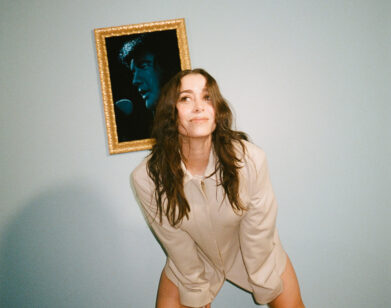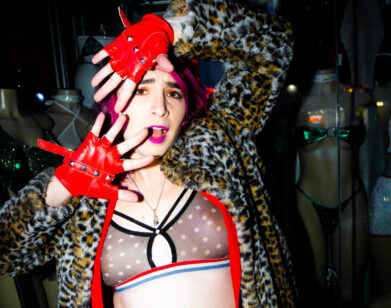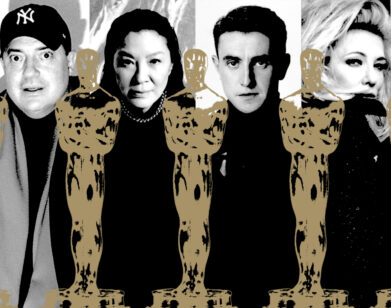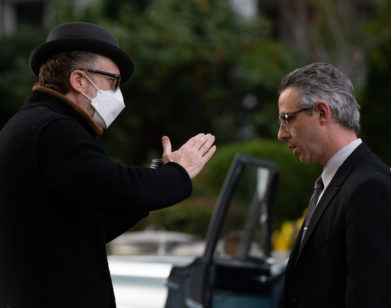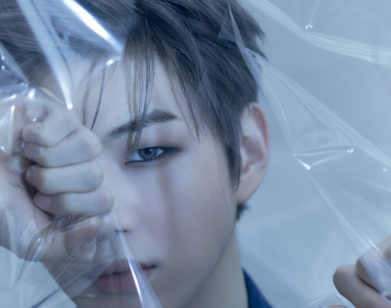in conversation
Matt Reeves Tells Andy Serkis How He Turned The Penguin Into a Leading Man
HBO’s latest Batman spin-off, The Penguin, is “a dark American dream story,” to use the words of the show’s executive producer, Matt Reeves. The series follows the ascent of Oz Cobb, a mid-level mobster known as the Penguin, as he transforms into the kingpin of Gotham City. “Batman comes out at night, but Oz is noir during the day,” Reeves told fellow filmmaker Andy Serkis on Zoom last week. The Penguin, of course, isn’t Reeves’ first foray into the Batman universe; he previously directed 2022’s The Batman, starring Robert Pattinson. But together with the show’s star Colin Farrell and showrunner Lauren LeFranc, Reeves has articulated his particular vision of a tragic mobster scheming for control of America’s most notorious make-believe metropolis. Below, he and Serkis discuss mythic pop, famous gangsters, and the freedom of profanity granted by HBO.
———
MATT REEVES: How are you, my friend?
ANDY SERKIS: So lovely to see you. I miss you so much.
REEVES: I was literally going, “I’m going to see Andy today.” I was so excited.
SERKIS: Oh, me too. I’ve just arrived in Paris. It took two and a half hours to get from London to Paris. An hour and a half to get from the station to the hotel in traffic.
REEVES: Oh my god.
SERKIS: Such is life. Wow. Okay.
REEVES: I’m happy to see you, that’s all.
SERKIS: I watched the first two episodes [of The Penguin]. I loved it.
REEVES: You saw the first two. Cool.
SERKIS: I genuinely thought it was a brilliant piece of television. It is so lovely to see a character have the time on screen that that character deserves.
REEVES: Yeah. That was the idea in doing the show really. The movies are so much about Rob, about Batman and Bruce, so I was excited about the idea of following a character and being in his point of view. It really gives you the time to look at a character that there would never be the real estate for in a movie, even though apparently, we make the longest Batman movies in history.
SERKIS: Come on. Well, when you first started working with Colin [Farrell] for the movie, what was your starting point? Did you have a strong idea about who this character was?
REEVES: No, we really arrived at that in an unexpected way. We didn’t do an origin tale for Batman, but he was a young Batman. So in my deep dive into the comics, I found that all of the major Rogues Gallery characters make themselves in reaction to Batman. This masked vigilante shows up in the city, and all of these people are remade in that light. I think what was exciting to me was thinking about a Penguin who was not yet the kingpin. He is underestimated. He’s mocked. He’s called the Penguin. It’s an insult because he has a limp. Everyone perceives him to a degree as a joke, but he has all of these deep-seated ambitions within him from his brokenness. It’s a dark American dream story. When I met with Colin, I said, “It’s the tip of the iceberg because his character is a red herring in the story.” We’re looking for an informant, and normally, a rat is a mid-level guy in the mob. So, I thought, “People will absolutely believe that he is the person we’re looking for.” When in fact, it was John Turturro, it was Carmine Falcone. So in this movie, we just scratch the surface of who he is. The idea was to continue the story in the next film in the wake of Falcone’s assassination. There actually was a scene that we cut out where he thinks he’s talking only to Selina, but she’s got the contact lenses in. Batman is witnessing this. And when he realizes that she wants to go down and work in the club, you suddenly see this vulnerability coming from him. You realize, “Oh, he actually cares about her. He has a crush on her.” When she says, “I don’t want your money, Oz,” that really wounds him. It’s this moment where you think, his life is one of being rejected and part of his ambition is driven by seeking some acceptance. Then he says, “I know nobody sees it, but one day this city’s going to be mine.” Colin did this thing. It was very dark in a great way that let you know that there was a lot more there. This is the longest answer ever to your question, but—
SERKIS: It’s great. It’s great.
REEVES: To answer your question in terms of the look, we never thought that Colin was going to look like that. Colin came from doing a movie. He deliberately had put some weight on, and I was like, “Oh.” Also, there was a version of the Penguin character in the video games called Telltale who physically looks a little bit like Colin. He’s handsome, except something happens to his nose in an altercation, and it looks beak-like. I was looking for that vulnerability. Colin is so handsome, so the idea was, “How can we mess up his face to show that vulnerability?” We started talking about John Cazale in The Godfather and how people just look at him as a joke. But the truth is that he would have this deep-seated wily rage and ambition within him to do some unspeakable things to get where he wants to go. That’s where it started. I brought in Mike Marino, who’s an incredible makeup artist. We talked about John Cazale, Al Capone, different gangsters. But my fear was that we hired Colin Farrell and somehow he’s transformed him entirely.” I need to believe that this is a real person, and I need Colin, who’s an incredible actor, to be able to express himself through this. If there’s any moment where it looks theatrical, like a guy in makeup, we’re dead. But the prosthetics are incredibly soft. It moves like skin. There was something extraordinary about it. So, we started doing some tests, and Colin sent me a video, and he’d been working on an accent. It was suddenly like another person was born. Something about being under that makeup freed him.
SERKIS: I remember bumping into him just outside of his trailer, and I’d never met Colin in any other way.
REEVES: Did you know it was him beforehand?
SERKIS: I knew. We just went up and gave each other a huge hug. I was like, “I’m hugging this guy, and he’s really scary and weird.” It was Colin underneath and it was just hilarious.
REEVES: It’s funny, we just went to Comic-Con, and I was there with Cristin Milioti who plays Sofia. I was talking about that to her, and she said, “I had the exact same experience.” Rhenzy Feliz, who plays Vic, same thing. They both said to me, “I know Colin more as Oz.” He’s such a lovely man.
SERKIS: And it’s such a beautiful character in the sense that there’s real tragedy about him and his relationship with his mother. He wants to be something that he isn’t quite yet. You really feel for him and you want to hate him, but you just can’t.
REEVES: Well, you’ll see, as the series goes on, it gets incredibly dark and he does things that are absolutely—
SERKIS: Wow.
REEVES: Not that anything he’s done is forgivable, but you can indulge to a degree. But he takes things to a place that’s very unsettling. It’s the dark American dream of reaching for some level of success, and about love being transactional and never being enough, being a void that can never be filled. So, the question was, where do those wounds come from? It was Lauren [LeFranc]’s idea that it came from his mother. She pitched that relationship. And he and Deirdre O’Connell have such incredible chemistry together. They seem to be dancing together, almost less like mother and child and more like… “What’s going on here?” Lauren took the story in a very disturbing place, but that relationship is very special, and those two actors together are really extraordinary.
SERKIS: How did working with Lauren come about?
REEVES: HBO really, really liked her and they said, “Will you read her stuff?” We really responded to her writing. Then we met her and we just really connected to her. Then I started describing my aims to her of taking these characters seriously and grounding these pop mythic characters in emotional reality. It was a different genre than people had done in Batman before. They’d never really done a detective story to that degree. She did her own deep dive, and she brought in Sofia Falcone and created Vic and the mother, and by the time we finished the movie, we had HBO on board with exactly what the story was. We’re trying to do another movie right now, which I’m writing with Mattson Tomlin. So, it’s a lot, but it’s a gift to do a show like this on HBO because their standards are so high. We’re just really lucky to be there. Casey and Sarah have been incredible, so it’s really neat.
SERKIS: Amazing. I’m really interested in how Sofia came about.
REEVES: I mean, we took Carmine from the comics and there was a lot of stuff from The Long Halloween, but I think there was something very personal that Lauren wanted to say with Sofia’s character. She enters the story in this really delicious way, because you’re like, “Who is this force of nature?” Cristin just embodies that so beautifully. She seems to be a foil in the beginning, and you are wondering, “What is their history together?” But I think it’s really about being a woman in a very male toxic world and how she’s going to rail against that to become this incredible force, which she does. And to do any story, and it certainly was this way when we were doing Apes, you always have to find your personal way in. When I was doing the first movie with you, Andrew, my son, was just starting to speak. And in the first movie when you said, “No!” That urgency, I saw Andrew having that. Being a father was reminding me that we are animals. So obviously, that was what we explored, and also the relationships between families, fathers and sons. And with Lauren, there was an opportunity to do something good because we love these characters. They’re mythic pop. I’ve loved Batman since I was a kid. She’s a big comic book fan. So it’s great to find a way to do something that resonates personally.
SERKIS: Yeah. It’s a beautifully drawn character, and Cristin is amazing. I couldn’t take my eyes off her.
REEVES: Yeah, very special.
SERKIS: I was very scared of what she was capable of doing.
REEVES: That’s great.
SERKIS: What about how Gotham is portrayed? Do you see that as a reflection of the world that we live in, or heightened? To me, it feels so spot on, but with a slightly elevated allegorical feel to it.
REEVES: Yeah, I wanted Gotham to be a city that is not New York or Chicago or Pittsburgh, but an American gothic city. I wanted it to feel like a city that you’d never quite been to before, so that it felt truly like its own place. But it was important to me that that place exists in our world, so that the audience coming to it would understand the wishful fulfillment and struggles of being in this gothic metropolis. It’s grounded in its corruption and desperation, and Gotham never gets better. It’s a good thing for the comics, because otherwise, Batman would be done with his mission. But there is something that is true about that in our world too. If we look at our great cities, of course, there are glorious things about them, but some things never are repaired. The disparities and extremes of Gotham for me is one of the reasons I wanted to do Batman. Batman is in the tower, but Oz is a grungy, street level gangster who is just in the muck. It’s very hard to make Batman not look silly in the wrong lighting conditions. Batman can’t walk into a 7-Eleven, he’s going to look like an idiot. He’s choosing where he can unveil himself. But Oz is not bound by what Batman is. Batman comes out at night, but Oz is noir during the day. So, suddenly, we could see Gotham through all these fresh ways. We talked about lighting, and how to find a way to do daytime noir. We’re looking at daytime stuff from The French Connection, things like that. Batman is like this slow brooding suspense thing. Everything’s very precise, the camera is always locked, even in the chase scenes. Oz, meanwhile, he’s improvising. He’s got this whole other energy. So we thought of doing handheld. From that point forward, we had a slightly different aesthetic that feels DNA connected. And we worked with Johnny Hahn, our VFX supervisor, to make New York and London feel like Gotham.
SERKIS: Which was beautifully done. I mean, it was seamless. It felt totally like the same world, but it was actually so much more disturbing during the day. That’s what I loved about it, I think.
REEVES: I would say that it’s very unflinching. That’s one of the things too, about being on HBO. It’s interesting because in a Batman movie, there are resources that are tremendous, so we’re able to do quite grand things, but we are handcuffed in other ways. When we were dealing with the ratings board, they were like, “You got to pull that back and this back.” But with HBO, those handcuffs were removed. It gave us the ability to be really character-forward. Even just the way that Oz can be so deliciously profane. Now as we’re working on the movie, he can’t be quite as free with the profanity. There is a wonderful tone to the way Colin does it, so we have to find the right balance.
SERKIS: That’s incredible. In terms of the gangster genre, what were your major sources of reference?
REEVES: For sure, Scarface, a dark American dream story. Also, when we were talking to Mike Marino, I was thinking of Bob Hoskins and The Long Good Friday as somebody with that coiled intensity.
SERKIS: Without going into too much detail, there’s a scene with Colin where it’s bare.
REEVES: Yeah.
SERKIS: It is offsetting.
REEVES: Not only is he bare, but he’s bare all the way because that was one of the things Colin asked for.
SERKIS: Really?
REEVES: It was not caught that way on film, but he was anatomically correct all the way through.
SERKIS: It takes your breath away. Seeing that character completely stripped down is just phenomenal.
REEVES: Again, kudos to Mike Marino. When you see his foot, that was one of those things too that Lauren wrote in the script. Then when Mike made that foot, we were like, “Wow.” Those details were so telling. The idea that he lived silently with that pain every day, and he was obviously scarred emotionally and psychically, but even physically. That’s one of the things that I loved in the story Lauren was pitching. Like when he loses control and kills Alberto in the first 10 minutes of the show. It reminded me of a Hitchcock movie because it’s super hard to get rid of a body. It’s super hard to kill someone actually. The messiness of that seemed very Hitchcockian. So the idea of having to take that body and somehow get him out of there while you’re struggling because of your foot, it’s the pain of all that.
SERKIS: In terms of the universe, do you see a rhythm? Do you think they’ll do The Penguin again or will you take us into Gotham through another lens?
REEVES: Yeah. We have been talking, and it’s exciting because people are now embracing the show. My fantasy is coming into being, which is very exciting, and HBO has been incredibly supportive from the beginning. Now to see that the show is being embraced is really, really exciting. We have been talking about doing other shows. I wanted to make sure that we didn’t do the origin tale, which so many of the other series have done. I think the idea of being able to put a lens on these characters is a really exciting idea. It’s about cities and their dysfunction and the world and its dysfunction, which is what Batman stories are all about. They’re all about Gotham being a place that should be better. And you can have the experience of this almost novelistic epic crime saga, but you also just get these separate experiences. They have their own dramatic value. So Oz’s story is Oz’s story, and the idea is to do these other stories in the same way.
SERKIS: Well, very rarely do you see the birth of a truly iconic character on TV, and I really do feel like I’ve seen this grow into one. Colin’s performance is extraordinary. It’s so layered and so nuanced, and he’s just a fearless actor.
REEVES: Yeah, it really is that. He just is fearless, and I think it has to do with his empathy. You’re going to go, “God, I hate this guy, but I see where that comes from and that does not make it okay.” There’s a sense of tragedy within all of that. He’s not a good guy.
SERKIS: The fact is you still feel for him, and that’s a testament to all of your work.
REEVES: Yeah, her writing is very, very special.
SERKIS: And Matt, you have the breadth to put all of those pieces in place. You are such an inspiration. You’re an amazing filmmaker and human being. In the wrong hands, this could have been so ordinary.
REEVES: Oh, I’m so glad you didn’t think it was.




